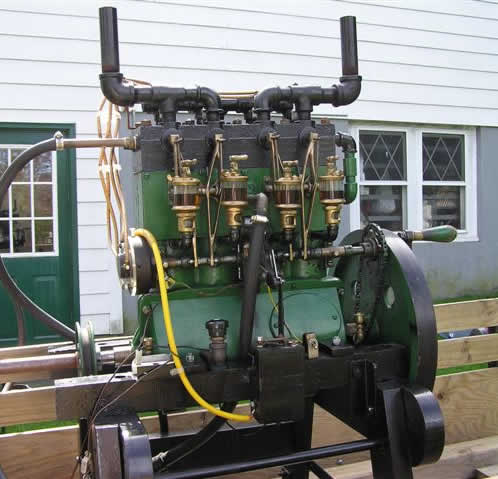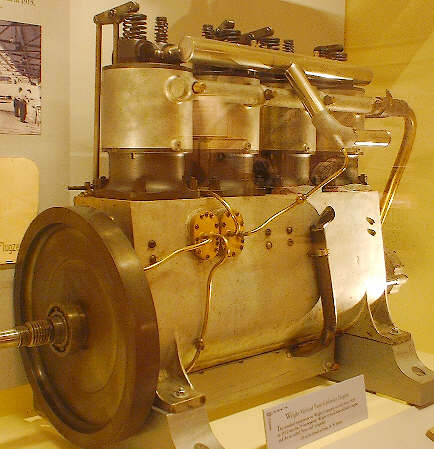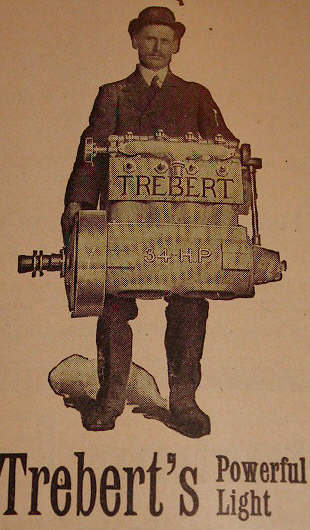| Author |
Message |
    
renault
New member
Username: renault
Post Number: 1
Registered: 09-2004
| | Posted on Saturday, September 11, 2004 - 02:32 pm: | 




|
This 4 cylinder 4-stroke inboard marine engine was found in the 1950's by a relative of mine, in a barn in Merrimac, Massachusetts, along with a propeller and shaft. My guess is that the boat rotted out and someone saved the engine from it.
It was given to my father who kept it in a shed for about 30 years, until he found out about antique engine shows. In the late 80's he started taking it to shows after getting it to run. I have inherited the engine and I am now enjoying taking it to shows. There is no name on it. There are no part numbers on it. I think someone had an idea for building an engine, and casted and machined this. The carburetur found on it is a Shebler, made of aluminum and brass, patent date October 14, 1902. The connecting rods are about 5/8" diameter, threaded on both ends with 11/16" hex jamb nuts. The intake valves are of the atmospheric type, opening from the suction of the piston. The crankshaft has only two crank throws. The pistons are paired up on each crank throw. The ignition system uses a vibrator coil and battery. In the early 90's we took it to the Mystic Sea Port Museum Marine Engine and Boat Exhibition, in Connecticut, and no one had seen one like it before. I bet its the only one!
 |
    
andrew
Moderator
Username: andrew
Post Number: 892
Registered: 11-2001

| | Posted on Saturday, September 11, 2004 - 03:08 pm: | 




|
renault,
Great story! And it looks like a very interesting engine. Do you have a larger photo (or multiple photos) that you could post?
If you had difficulty reducing it, send me the original by email and I will post it larger here. |
    
andrew
Moderator
Username: andrew
Post Number: 893
Registered: 11-2001

| | Posted on Saturday, September 11, 2004 - 04:06 pm: | 




|
Al sent me the pictures and some more info:
quote:Hi Andrew.
I did have trouble with the photo size, and I do have other photos. See attached.
I must mention that the carburetur you see on this engine is not the Shebler, but a Briggs & Stratton (6H.P) carb. I intend to resurrect the Shebler eventually. As you probably can tell, the propeller is just for show.
Thanks,
Al




 |
    
larry_from_maryland
Senior Member
Username: larry_from_maryland
Post Number: 169
Registered: 07-2003
| | Posted on Saturday, September 11, 2004 - 07:03 pm: | 




|
Looking at that it looks similar to the wright tomson engines used in the wright flyier. |
    
thomas
Senior Member
Username: thomas
Post Number: 214
Registered: 07-2002

| | Posted on Sunday, September 12, 2004 - 12:10 pm: | 




|
I do not ever remember seeing side rocker arms
on anything. The chain drive camshaftis also
a little odd (Chain drive mag is more common).
Look how the crankcase is split at an angle. Why would that be? How come there is only one oval shaped inspection port for the front 2 cylinders?
What is a Wright Tomson engine? In the Smithsonian A&S building there are several Wright horizontal 4 cylinder (early make&break)
and the later upright 4 cylinder with mag powered spark ignition. They have push rods to operate the valves and a gear drive internal camshaft |
    
thomas
Senior Member
Username: thomas
Post Number: 215
Registered: 07-2002

| | Posted on Sunday, September 12, 2004 - 12:11 pm: | 




|
 |
    
thomas
Senior Member
Username: thomas
Post Number: 216
Registered: 07-2002

| | Posted on Sunday, September 12, 2004 - 12:13 pm: | 




|
 |
    
thomas
Senior Member
Username: thomas
Post Number: 217
Registered: 07-2002

| | Posted on Sunday, September 12, 2004 - 12:15 pm: | 




|
The first engine is in the A&S DC museum, The second one is in the new A&S site at Dullas in Va. |
    
larry_from_maryland
Senior Member
Username: larry_from_maryland
Post Number: 170
Registered: 07-2003
| | Posted on Sunday, September 12, 2004 - 01:05 pm: | 




|
You got great pictures.I saw an interview of the guy that built the engines he said he just took large blocks of aluninum and started cutting holes untill he had the engine.I thought he said his name was thomson.Obiously not the same but still early rought cut engines. |
    
renault
New member
Username: renault
Post Number: 2
Registered: 09-2004
| | Posted on Sunday, September 12, 2004 - 05:27 pm: | 




|
Thomas, I think I can explain the oval cover on the crankcase. Under that cover is a slightly jaggered hole. I think the connecting rod next to that hole broke at one time. The piston at that location has a small piece missing from the piston skirt also. My guess is that the check ball for the oiler for that cylinder escaped its location, rolled into the cylinder, caught the piston skirt, broke the connecting rod, and caused the rod to make the hole. Also, regarding the split angle crankcase, the crankcase has a center wall in it, separating the pairs of cylinders. Each wall half has a 1/2-round bronze bearing to support the center journal of the crankshaft. I guess this means that crankcase flange gasket thickness dictates the proper bearing-to-crankshaft journal clearance at that location.
Regards,
Al |
    
thomas
Senior Member
Username: thomas
Post Number: 218
Registered: 07-2002

| | Posted on Monday, September 13, 2004 - 08:41 pm: | 




|
Thanks for the info on the "patch" in the crankcase (they did a good job in those days).
I am loading a picture of a Trebert motor. Look at the sguare shape. I realize it has a different
camshaft drive but we can't see the side where the side rockers would be (if they were there).
I also searched for "Able" to find the picture of that square sided 2 cycle I have. |
    
thomas
Senior Member
Username: thomas
Post Number: 219
Registered: 07-2002

| | Posted on Monday, September 13, 2004 - 08:42 pm: | 




|
 |
    
thomas
Senior Member
Username: thomas
Post Number: 220
Registered: 07-2002

| | Posted on Monday, September 13, 2004 - 08:44 pm: | 




|
I forgot to mention that the Trebert picture was in a 1906 Rudder. |
    
renault
New member
Username: renault
Post Number: 3
Registered: 09-2004
| | Posted on Tuesday, September 14, 2004 - 05:43 pm: | 




|
Thomas, thanks for posting the Trebert photo. It appears that it has a cast intake manifold. On my engine, both intake and exhaust manifolds are a confusing assemblage of pipes,tees, and elbows. I think there are left- and right-hand threads involved, and it probably took the hands of several people to thread things together simuiltaneously.
Parts of this engine look professionally made, and, like the manifolds, other parts of it look crude. Also, as a point of interest, the cams on the camshaft are all setscrewed in place.
Regards,
Al |


